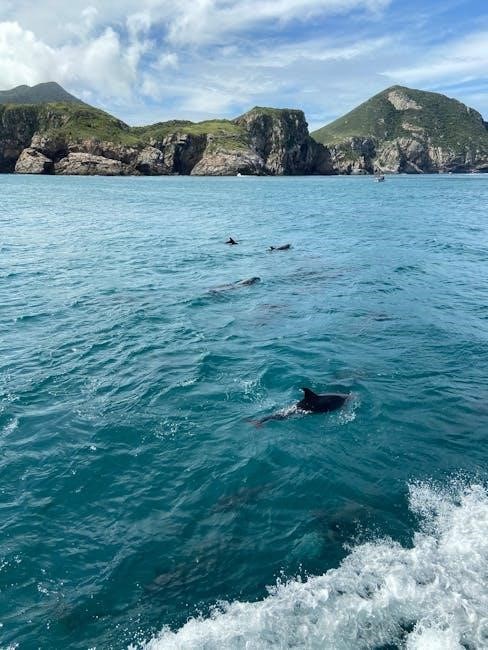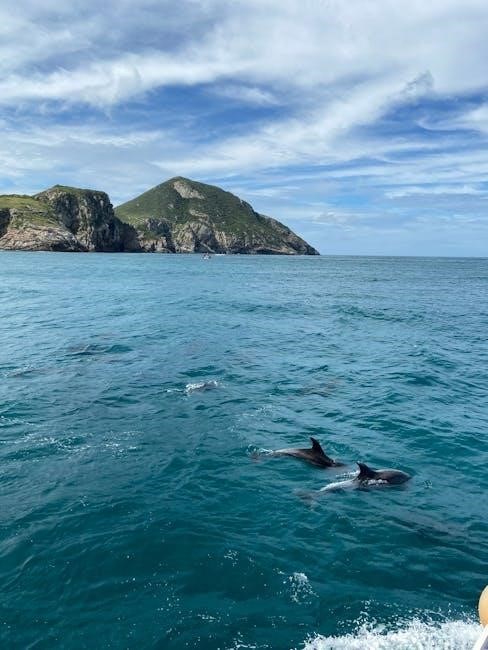
Based on the true story of the Lone Woman of San Nicolas Island, Island of the Blue Dolphins by Scott O’Dell follows Karana, a Native American girl, as she survives alone for 18 years off the California coast, exploring themes of resilience, independence, and harmony with nature.
Overview of the Novel
Island of the Blue Dolphins, written by Scott O’Dell in 1960, is a captivating children’s novel based on the true story of the Lone Woman of San Nicolas Island. The story follows Karana, a young Native American girl, who is accidentally left behind by her tribe during their relocation to the mainland. Stranded on a remote island off the California coast, Karana faces immense challenges as she learns to survive alone. Initially filled with despair and loneliness, she gradually discovers her inner strength and resourcefulness. Over time, she adapts to her environment, builds shelter, hunts for food, and fends off wild animals. The novel vividly portrays her journey of growth, resilience, and self-discovery, highlighting themes of survival, independence, and harmony with nature. Karana’s story is not only a testament to human endurance but also a celebration of the deep connection between individuals and their surroundings.
The Author and Historical Context
Scott O’Dell, an American author, wrote Island of the Blue Dolphins in 1960, drawing inspiration from the true story of Juana Maria, the Lone Woman of San Nicolas Island. Born in 1898, O’Dell was known for his historical fiction that often highlighted the experiences of indigenous cultures and their struggles with colonialism. The novel is set in the early 19th century, reflecting the era of Native American displacement and the arrival of European settlers. O’Dell’s work not only brings attention to the forgotten history of the Nicoleño people but also emphasizes the resilience and adaptability of its protagonist, Karana. The book has become a cornerstone of children’s literature, earning the Newbery Medal in 1961 and continuing to educate readers about the clash of cultures and the enduring spirit of survival.
Themes of the Novel
The novel explores themes of survival, independence, solitude, and friendship, while addressing gender roles and environmental awareness, all set against the backdrop of colonialism and indigenous resilience.
Survival and Independence
Karana’s journey on the island is a testament to her resilience and resourcefulness. Initially overwhelmed by isolation, she learns to fend for herself, discovering how to hunt, build shelter, and create weapons. Over time, she adapts to the island’s rhythms, mastering the skills necessary for survival. Her ability to thrive in solitude reflects her growing independence and self-reliance. The novel highlights her transformation from a frightened girl to a confident individual capable of overcoming challenges. Karana’s experiences underscore the importance of adaptability and courage in the face of adversity, making her story a powerful exploration of survival and personal growth.
Solitude and Friendship
Karana’s life on the island is marked by profound solitude, yet she finds unexpected companionship in the natural world. Initially, the isolation feels overwhelming, but she learns to embrace her alone-ness, discovering strength within herself. Her friendship with Rontu, a wild dog, and later with the otters, brings comfort and joy to her isolated existence. These relationships highlight the transformative power of connection, even in the absence of human interaction. Through her bonds with animals, Karana learns empathy and understanding, which aid her survival and emotional well-being. Her story shows that solitude can foster self-discovery, while friendship, in its many forms, provides solace and meaning in challenging circumstances.
Gender Roles and Cultural Expectations
In Island of the Blue Dolphins, Karana’s journey challenges traditional gender roles within her Native American community. Raised in a society where women are expected to perform domestic tasks while men hunt and lead, Karana defies these norms out of necessity. After being stranded on the island, she learns to hunt, build weapons, and fend for herself, activities typically reserved for men. Her resourcefulness and adaptability highlight the rigid constraints of her culture while showcasing her resilience. The novel underscores the limitations imposed by societal expectations and how Karana’s isolation forces her to redefine what it means to be a woman in her world. Through her experiences, the story critiques colonial and patriarchal norms, offering a powerful narrative of female empowerment and self-discovery.

Historical Basis of the Story
The novel is based on the true story of Juana Maria, a Nicoleño Native American woman who lived alone on San Nicolas Island for 18 years in the early 19th century. Scott O’Dell’s fictionalized account captures her resilience and survival, connecting the story to real historical events and the experiences of Indigenous peoples during colonial times.
The Lone Woman of San Nicolas Island
The Lone Woman of San Nicolas Island, later identified as Juana Maria, was a Nicoleño Native American who lived alone on San Nicolas Island for 18 years in the early 19th century. Her story, preserved in historical records, inspired Scott O’Dell’s novel Island of the Blue Dolphins. Juana Maria’s isolation began when her tribe was relocated, and she was accidentally left behind. She survived by adapting to the island’s resources, building shelter, and fending off wild animals. Archaeological discoveries, including a sandstone cave believed to be her home, have corroborated her story. Juana Maria’s resilience and resourcefulness highlight the strength of Indigenous peoples in the face of colonial displacement. Her legacy endures as a symbol of survival and adaptation, bridging history and fiction through O’Dell’s acclaimed novel.

Main Character Analysis
Karana, the young Native American protagonist, embodies resilience and growth as she navigates isolation on the island, learning to hunt, build shelter, and fend off dangers, transforming from a dependent girl into a self-reliant survivor.
Karana: Her Journey and Growth
Karana, a young Native American girl, undergoes a profound transformation during her 18-year solitude on San Nicolas Island. Initially dependent on her tribe, she learns to hunt, build shelter, and fend off wild dogs, showcasing her resilience. Her journey is marked by grief, loneliness, and self-discovery, as she adapts to her isolated life. Over time, Karana evolves from a scared child into a resourceful and independent individual, finding solace in nature and forming unexpected friendships with animals. Her growth reflects not only physical survival but also emotional maturity, as she learns to forgive and coexist with her environment. Karana’s story is a testament to the human spirit’s ability to thrive in adversity, making her one of literature’s most inspiring protagonists.

Key Lessons from the Novel
The novel teaches survival, environmental harmony, and forgiveness, emphasizing self-reliance and coexistence, while highlighting resilience and adaptability in the face of isolation and adversity.
Environmental Awareness and Adaptation
Karana’s journey highlights her deep connection with nature, showcasing her ability to adapt to the island’s challenging environment. She learns to identify edible plants, build shelters, and craft tools, demonstrating resourcefulness and respect for the natural world. The novel underscores the importance of living in harmony with ecosystems rather than exploiting them. Through Karana’s experiences, readers gain insights into the value of environmental awareness and sustainable living. Her story serves as a timeless lesson on adapting to one’s surroundings and preserving the balance of nature for future generations. This theme remains central to the novel, emphasizing survival through understanding and coexisting with the environment.
Forgiveness and Coexistence
Karana’s story in Island of the Blue Dolphins emphasizes the power of forgiveness and coexistence. Despite the hardships and losses she endures, Karana learns to let go of hatred and anger. Her ability to befriend the wild dogs and even spare the life of a young Aleut hunter reflects her growing capacity for compassion. This theme is central to her survival and personal growth, as she realizes that violence only perpetuates suffering. By choosing forgiveness, Karana finds inner peace and learns to coexist with the world around her, even in the face of adversity. The novel teaches readers that forgiveness is not weakness but strength, and that coexistence with others and nature is essential for true harmony. This lesson remains a profound takeaway from Karana’s journey on the island.

Cultural Significance
Island of the Blue Dolphins highlights the impact of colonialism on indigenous cultures, offering a powerful portrayal of resilience and the preservation of Native American history and heritage.
Impact on Indigenous Culture and Colonialism
The novel sheds light on the devastating effects of colonialism on indigenous communities. The arrival of outsiders disrupts the peaceful life of Karana’s tribe, leading to violence and displacement. The story emphasizes the loss of cultural identity and traditions as Native Americans are forced to adapt to foreign influences. Karana’s isolation serves as a metaphor for the broader struggles of indigenous peoples facing encroachment and marginalization. By portraying her resilience and connection to her heritage, O’Dell’s work raises awareness about the importance of preserving indigenous cultures. The novel critiques colonialism’s destructive impact and honors the endurance of Native American traditions, making it a significant piece in discussions about cultural preservation and historical justice.
Island of the Blue Dolphins is a poignant tale of survival, resilience, and self-discovery, offering timeless lessons about nature, solitude, and cultural identity. Karana’s journey from a frightened girl to a capable, independent woman inspires reflection on humanity’s relationship with the environment. The novel highlights the importance of forgiveness and coexistence, even in the face of adversity. By drawing from the true story of the Lone Woman of San Nicolas Island, O’Dell crafts a story that honors indigenous heritage while addressing the challenges of colonialism. Karana’s enduring spirit and deep connection to her land leave readers with a profound appreciation for the natural world and the strength of the human spirit. This beloved novel remains a vital exploration of survival, identity, and the enduring legacy of Native American culture.




